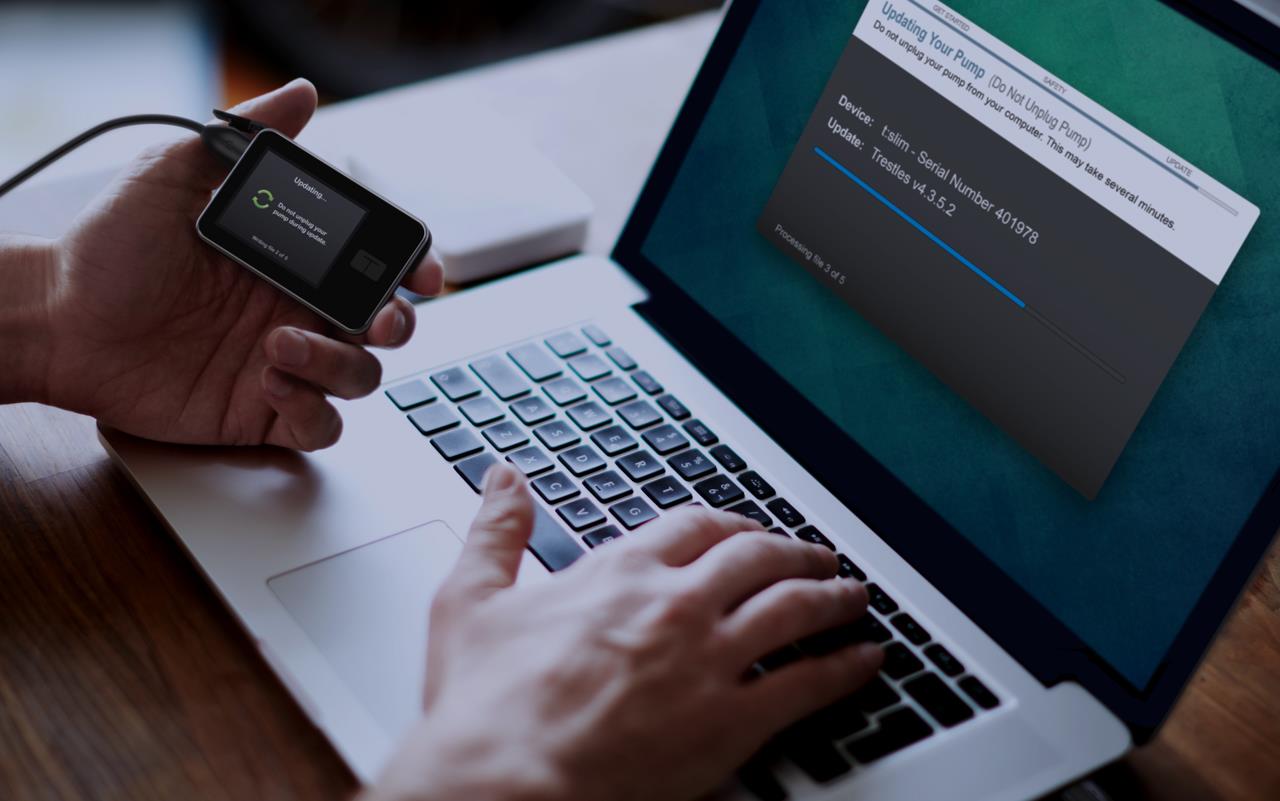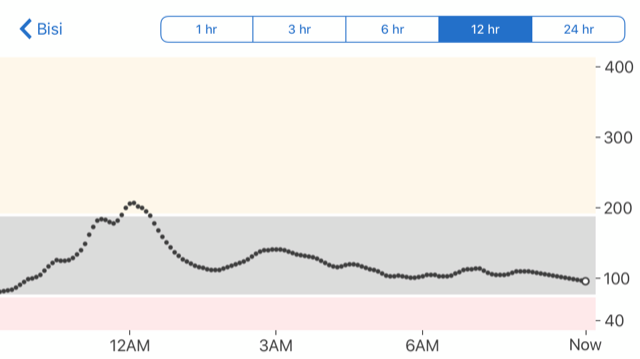Control-IQ: The Good, the Challenges, and Tips
By Katie Bacon

After a month of her daughter using Control-IQ, Katie Bacon reviews the pros and cons of the algorithm and shares her family’s tips and takeaways
When the email came through in early April that our daughter, Bisi, could now download the software to run Control-IQ on her t:slim insulin pump, the timing seemed perfect. After all, our family was staying at home due to COVID-19, so we had plenty of time together to do the training and figure out the new system and how it worked for Bisi and her blood glucose levels. Plus, from everything I’d read about COVID, keeping blood sugars as stable as possible was more important than ever, and it seemed like Control-IQ could help us with that. (The Control-IQ algorithm uses data from Dexcom’s CGM to lower insulin delivery when a low is predicted and to increase insulin when a high is predicted – learn more about Control-IQ here.)
Bisi has now been on the new system for about a month, and while it hasn’t been a magic bullet and we’re still learning, Control-IQ has improved Bisi’s time in range by about 5% (and we’re hopeful that her time in range will continue to improve). Also, even more importantly, it’s improved her quality of life – and ours, as the parents who watch out for her. When I sat down with Bisi recently to ask her about the change, I got her perspective on the burden she feels diabetes has placed on her – and the power of Control-IQ to lighten that load. She told me that before using Control-IQ, at any given time 30-40% of her focus was on diabetes. I was taken aback by this percentage, since Mark (my husband) and I have always tried to take some of the weight for her. As she told me, “It feels demanding, like a lot of pressure, as if someone’s poking my head.” But with Control-IQ, she says, she doesn’t need to worry about much except bolusing insulin at mealtime. She has fewer highs, fewer lows, and she says she feels better physically than she did before. “For as long as I can remember, diabetes has been a main focus of my life, but it really shouldn’t be that way. So it’s been nice not to focus on it as much,” she said.
In terms of what Bisi has experienced over the past few weeks since switching to Control-IQ, I’ve divided my thoughts into the pros and cons of the system as we’ve experienced it; I’ve also included tips drawn from what we’ve learned from Bisi’s endocrinologist and DCES.
Pros of Control-IQ:
We’ve found that Control-IQ works particularly well at night, when Bisi isn’t eating anything or bolusing. While our nights had already improved with Basal-IQ (which did a good job minimizing Bisi’s lows), Control-IQ brings down any highs as well (see the graph on the right). I’d say that when Bisi’s pump only dealt with the lows, we still had to wake up maybe six to eight nights a month, on average – and sometimes multiple times in one night. But in the month since Bisi started on Control-IQ, we’ve only had to wake up three times. This is a big change in our quality of sleep (and quality of life).
-
Control-IQ helps keep blood sugars down during the day. As before, Bisi’s blood sugars are less stable during the day, when her activity is variable and when she’s eating meals and snacks. But now, Control-IQ raises her basal rate when she’s headed high and gives modified boluses (60% of what’s called for) if the highs are sustained. We’ve found that her blood sugar does not rise as steeply, according to her CGM, and also that it often tops out at a lower number than it used to.
Cons of Control-IQ:
-
There were a few instances where Bisi had sustained lows that were more difficult than usual to counteract with carbohydrates. These instances have all been when she’s started exercising with a lot of active insulin on board, due to Control-IQ turning up her basal rate in response to a high. Before using Control-IQ, if Bisi’s blood sugar was high, she (maybe with a reminder from me) would have to make a decision to either turn up her basal or give a correction. If she knew that she was going to get exercise in the near future, she wouldn’t do either of those things. But now they happen automatically, so she’s sometimes stuck with too much active insulin on board. It requires a different kind of thinking and a different kind of planning than before.
-
Both Bisi and I wish there were a little more flexibility in Control-IQ so she could set her own target. Bisi used to set her target at 100 day and night, and would often run at 80 or 90 while she was sleeping. With Control-IQ’s built in Sleep Mode target of 110, Bisi runs a little higher than she is used to, especially at night.
Thoughts and Tips for using Control-IQ:
-
We have found that being consistent about pre-meal bolusing is even more important with Control-IQ than it was before. If Bisi waits too long to bolus, her blood sugar goes too high, she gets more basal and an extra 60% bolus from Control-IQ, and then her blood sugar goes too low later on.
-
While it might seem like Control-IQ could enable people to be a little freer in what they eat, so far it has emphasized the benefits of eating low carb as the best way to avoid food-related spikes and insulin-related dips. No matter how good an algorithm is, it’s always going to be reactive rather than proactive, and we’ve found that the smaller the inputs in terms of number of carbs eaten, the more smoothly Control-IQ works. (I think this is partly why it tends to work better for Bisi at night, when she’s not eating anything, than during the day.)
-
Bisi’s endocrinologist validated our sense that exercise-related lows can be steeper with Control-IQ, since you tend to have more active insulin on board. Because you can’t do a temporary basal rate with Control-IQ, she suggested that we set up an alternate program with basal rates cut by 50%. If Bisi knows she’s going to exercise, she can turn on this alternate program 90 minutes to 2 hours before. Or, if she’s eating beforehand, she can put in fewer carbs/give less insulin. Either way, the trick is remembering.
-
During Bisi’s most recent appointment, her endocrinologist pointed us to a feature of Bisi’s Tandem reports that’s helpful to look at as a way to adjust settings. She told us to focus on the difference in the Logbook section between the Basal Total Delivered and the Basal Profile Setting, as a way to tell whether her basal rate at any given time should be raised or lowered; the closer the settings are to the amount of insulin that’s being delivered, the more smoothly the Control-IQ algorithm will work. She also suggested that we “Marie Kondo” (streamline and declutter) Bisi’s basal rates, which had proliferated over time, to help us see more easily where adjustments need to be made.
-
We realized that if Bisi has a random high blood sugar, particularly at night, we should assume that something has gone wrong with her pump site. Before Control-IQ, pump site failure was only one of several reasons – including the dawn phenomenon and the meal she’d eaten the night before – that her blood sugar might have gone high. This realization has helped us reduce that middle of the night detective work, when your brain is at its foggiest. If Bisi has a persistent high, the problem is most likely the pump site, not the algorithm.
-
One adjustment that Bisi has struggled with is remembering to turn off her insulin when she takes off her pump to shower or play sports. (The Control-IQ algorithm is thrown off when the system doesn’t have an accurate sense of how much insulin you have on board.) This is a work in progress for us.
Even though we still feel like we have more work to do in terms of getting the best out of the new algorithm, Control-IQ has improved Bisi’s life in important ways. As Bisi’s endocrinologist told us, “It’s not perfect, and you need to think more about active insulin than you did before. But the goal with this is to have diabetes interrupt your life less than it did before.” For Bisi, the important aim of staying in range now requires less mental effort. As she said recently when looking at her CGM graph after 24 hours of Control-IQ: “This is pure gold.”
This article is part of a series on time in range.
The diaTribe Foundation, in concert with the Time in Range Coalition, is committed to helping people with diabetes and their caregivers understand time in range to maximize patients' health. Learn more about the Time in Range Coalition here.









